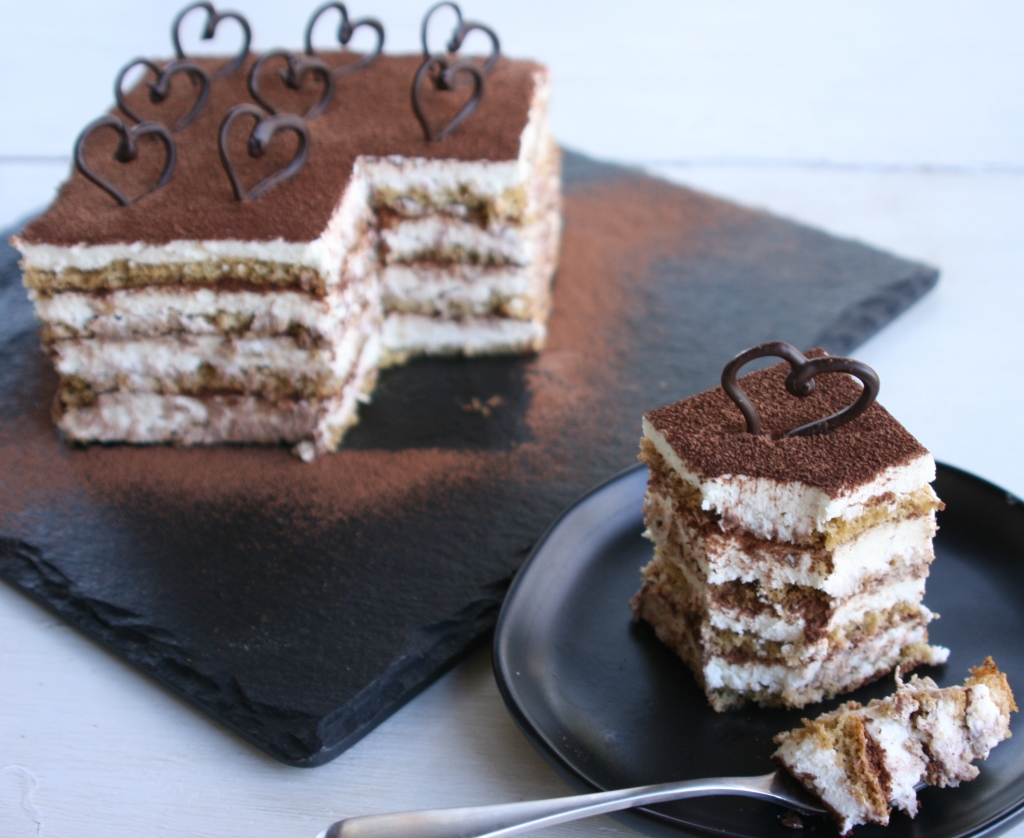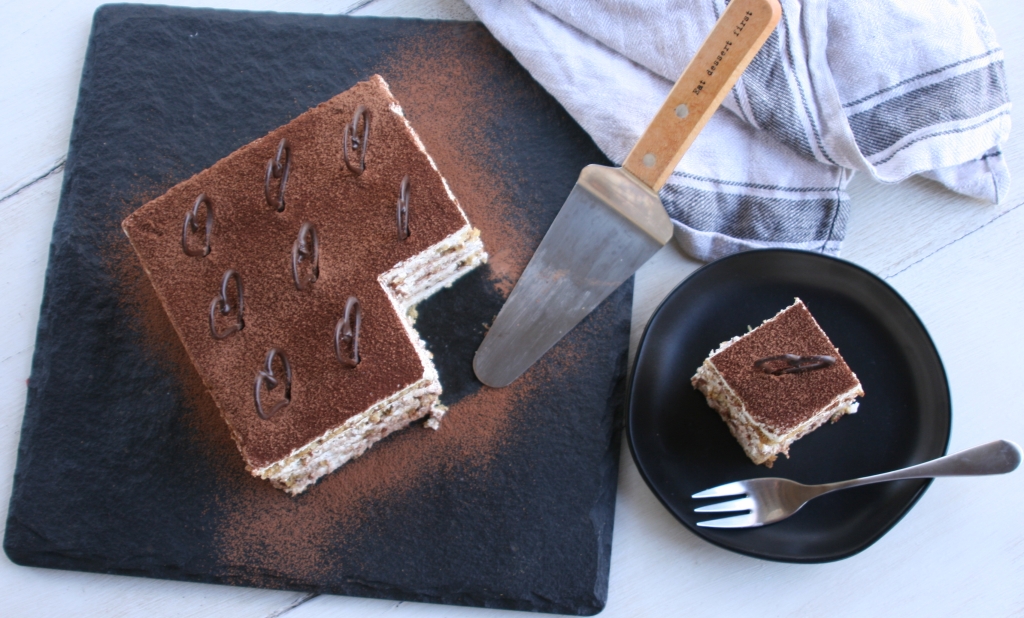Tiramisu — what’s not to love? Layers of creamy mascarpone separated by shaved dark chocolate and ladyfingers dipped in coffee. One bite and I’m transported back to the canal-side cafés of Venice, watching colorful gondolas glide past as the flavors mingle on my tongue.

While tiramisu is the most iconic of Italian desserts, this national treasure has a hotly contested origin story. Not only does it have its own Academy of Tiramisu, dedicated to preserving the culture of this famous dessert, it was even recognized by the Italian government in 2017 as a prodotto agroalimentare tradizionale, an officially approved, traditional regional specialty of the Friuli Venezia Giulia region. But therein lies the controversy.
According to legend (and the Academy), tiramisu (The word is derived from the phrase Tireme su, meaning “pick-me-up,” in the Treviso dialect.) was invented around the turn of the 19th century by the madam of a brothel, who served it to her clients as an aphrodisiac (thus the name!). As legends go, it’s got all the right elements, but in more academic circles, the dessert’s history is more mundane.
It’s the tale of two restaurants, and it takes place in the much more recent past of the mid-20th century. In Treviso, a town in the region of Veneto in the northeast part of Italy, the restaurant Le Beccherie added tiramisu to its menu in the early 1970s, staking claim to the title of tiramisu’s birthplace. However, across the border in the Friuli region, in the Alpine town of Tolmezzo, the chef and proprietress of the Albergo Roma hotel, Norma Pielli, produced a recipe dating from the 1950s for a dessert that her husband had christened tiramisu.
The Italian government seems to have sided with Sig.ra. Pielli, having officially tied tiramisu to the Friuli region, although Veneto officials have threatened legal action in retaliation.

We shall leave that dispute to the Italians, however, as we turn to Mary Berry’s version, which she dubs a “tiramisu cake.” It wouldn’t qualify as an authentic tiramisu, since hers uses a fatless sponge in lieu of ladyfingers, omits adding eggs to the mascarpone and includes a generous portion of brandy in the coffee mixture. But it’s just as creamy and decadent as the original and practically melts in your mouth.
This was the technical challenge put before the bakers in the Great White Tent for dessert week, and Mary was looking for precision, with even layers of sponge and cream separated by chocolate shavings, and each layer had to be soaked evenly with the coffee and brandy mixture.
For the sponge, I would recommend having all your ingredients measured out ahead of time, with the flour and baking powder sifted together and ready to sprinkle over the egg mixture as soon as it is beaten to ribbon stage. This will ensure that the eggs don’t lose any air while waiting for you to measure and sift the flour. (And yes, I may be speaking from experience here.) Then fold the flour in gently so the whole mixture will still be light and fluffy. Also, when transferring it to the prepared Swiss roll pan, pour it from a low height, just above the pan, to retain as much air as possible.
The other tricky part is cutting the sponge into even layers. After letting it cool completely, I suggest first cutting the cake into two squares by tracing around the bottom of your square cake pan. (Mary’s recipe calls for a 7-inch square tin, but I used a 6-inch tin and had enough ingredients left over to make a small trifle.) Then, using a long serrated knife, carefully cut horizontally through the middle of each square, so each piece is split into two thin layers.
Line the square pan with two strips of parchment paper long enough that the ends hang over the sides. These will ultimately be your “handles” to lift the cake out of the pan before serving.
After mixing together the coffee, hot water and brandy; shaving the chocolate (I used a microplane zester); and whipping the mascarpone cheese with cream and powdered sugar, it’s time to assemble the cake.


Start by placing one cake layer, cut side up, in the bottom of the prepared tin. Brush it with a quarter of the coffee mixture, then spread on a quarter of the mascarpone cream. (I found that piping it on first made it easier to ensure that it was spread evenly.) Sprinkle that with a third of the shaved chocolate.
Repeat with another layer of cake, coffee, cream and chocolate two more times. You may want to press down gently on each cake layer before adding the coffee to make sure the cream layer underneath is even and there are no gaps. Finally, put in place the last layer of cake, coffee and cream, and chill for at least an hour. You can even keep it in the fridge overnight if you’re not serving it until the next day.


This will give you time to make the chocolate decorations for the top of the cake. Follow the directions in the recipe below for tempering the chocolate, or use the easier method demonstrated in this video. Pipe it into any shapes you want.
When you’re ready to serve the cake, pull it out of the pan with the ends of the parchment paper. (I will admit that having a loose-bottomed pan makes this step a lot easier.) Place it on a serving plate and slide the paper out from under it, using a metal spatula to lift it slightly if necessary. Sprinkle the cake with cocoa powder, and insert your chocolate decorations on top.
Whether this dessert is truly an aphrodisiac or not, it definitely would make a romantic end to a special dinner. It’s rich and sumptuous and sure to impress that certain someone. That’s amore!

You can find Mary’s recipe here, but I have adapted it for American bakers below.

Mary Berry’s Tiramisu Cake
(Adapted for American bakers)
For the sponge:
For the filling:
- 1 T. instant coffee granules
- 2/3 c. boiling water
- ½ c. brandy
- 9 oz. full-fat mascarpone cheese
- 1 1/3 c. heavy cream
- 3 T. powdered sugar, sifted
- 2¼ oz. dark chocolate, grated
For the decoration:
- 3½ oz. dark chocolate, finely chopped
- 2 T. cocoa powder
Directions
- Preheat oven to 350°F. Grease a 15×10-inch Swiss roll pan and line it with parchment paper. Sift the flour and baking powder together and set aside.
- Using an electric mixer fitted with a whisk attachment, whisk together the eggs and sugar for about five minutes, or until the mixture is very pale and thick, leaving a light trail on the surface for a few seconds when the whisk is lifted out of the bowl.
- Add the flour mixture to the egg mixture and fold it in gently, using a metal spoon or rubber spatula, taking care not to overmix. Pour the mixture into the prepared cake pan and tilt the pan from side to side to spread the mixture evenly. Bake for 20 minutes or until the cake is risen, golden-brown and springs back when pressed lightly. Cool in the pan for five minutes, then turn out onto a wire rack and leave to cool completely.
- Meanwhile, for the filling, dissolve the coffee in the boiling water and add the brandy. Set aside to cool.
- When the cake has cooled, use the base of a 7-inch square cake pan as a guide to cut two squares from the cake. (Save the trimmings for snacking later, or use them to make a small trifle.) Carefully slice the two cake squares in half horizontally so you have four thin squares of equal depth.
- Line the base and sides of the square pan with long rectangles of parchment paper. They should be long enough so that they hang over the sides of the pan; you will need to use them to help lift the cake out of the pan later.
- In a large mixer bowl, beat the mascarpone cheese until smooth. Gradually add in the cream and powdered sugar and beat until creamy and spreadable.
- To assemble, place one cake square in the bottom of the lined cake pan. Brush with one-quarter of the coffee brandy mixture. Then spread one-quarter of the mascarpone cream evenly over the soaked sponge. Sprinkle one-third of the grated chocolate over the cream.
- Place the second layer of cake on top of the chocolate, brush with another quarter of the coffee mixture, and then spread another quarter of the cream over the soaked sponge. Sprinkle another one-third of the grated chocolate over that. Repeat with the third cake layer and another one-quarter of the coffee mixture and cream and the remaining grated chocolate.
- Place the fourth cake layer on top and brush over the remaining coffee mixture. Spread with the last quarter of the cream. Chill in the fridge for at least one hour (or overnight).
- While the cake is chilling, melt two-thirds of the chopped chocolate in a small bowl set over a pan of gently simmering water. (Do not let the bottom of the bowl touch the water.) Gently stir the chocolate until it reaches 110°-115°F.
- Remove the bowl from the heat and continue stirring until all the chocolate is melted. Then add the remaining half of the chopped chocolate and continuing stirring gently until the chocolate cools to 95°-100°F or lower and is thick enough to pipe.
- Spoon the melted chocolate into a piping bag fitted with a small plain tip, or use a ziplock bag with a small hole cut in one corner. Pipe decorative shapes onto a piece of wax paper and leave to set.
- When ready to serve, use the ends of the parchment paper to lift the cake out of the pan onto a serving plate. Pull the parchment out from under the cake, using a metal spatula to lift the cake slightly, if needed. Dust the surface of the cake with the cocoa powder and decorate with the chocolate shapes. Cut into squares to serve.



1 thought on “Tiramisu Cake”